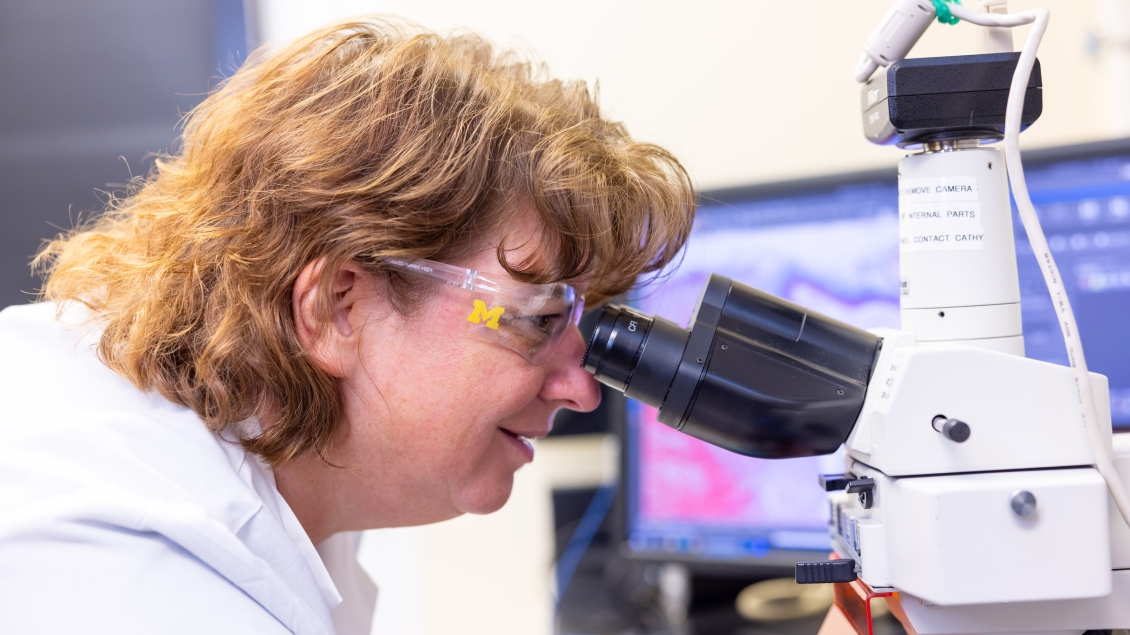
Myers Lab Overview
Learn more about the Myers Lab's work and impact.
Much of our work looks at the biology of selectins, cell adhesion molecules involved in signaling to the vascular epithelium. In particular, selectins signal platelets, monocytes and neutrophils, among other cell types, to move to the site of vascular injury, where clots are likely to form. Other investigators in the Conrad Jobst Vascular Research Laboratories have shown that some of these cells — monocytes, for example — are in fact critical to clot resolution, but at later points in time. As a result, our work aims to find ways to interrupt, rather than turn off altogether, these signaling mechanisms.
To better understand the processes and mechanisms involved in vascular disease and venous thrombosis and to identify and evaluate potential new therapies, we use a range of strategies, including:
- Translational model animal development
- In vivo and molecular methods to identify potential therapeutic targets, such as P and E selectin, to define their role in thrombus formation and resolution
- Evaluation of novel therapeutics, such as selectin inhibitors and low-molecular-weight heparin
- Evaluation of novel devices, such as the resuscitative endovascular balloon occlusion of the aorta (REBOA) catheter, for thrombolysis
- Medical device testing in large animal models of disease
- Pharmacokinetics and Pharmacodynamics in vivo studies to evaluate novel therapeutics
The Myers Laboratory works collaboratively with investigators in the Conrad Jobst Vascular Research Laboratories, industry, as well as nationally and internationally to translate findings into clinical trials.
Our work is advancing the understanding of thrombosis, including the body's immune response to oxidative injury and timing of key events in pathogenesis. For example, it was initially thought that inflammatory cells, such as neutrophils and monocytes, had a harmful impact on clot formation and should be eliminated. But these cells serve important purposes in thrombus resolution, too, so it's critical not to turn them off. By better understanding their mechanisms and receptors, we are aiming to interrupt their work long enough to get patients past the threat of clot formation.
Our work identifying and evaluating new anticoagulants with fewer risks is moving us closer to alleviating and preventing thrombosis and protecting the vessel wall in the event it does occur. More specifically, we have shown that selectin inhibitors, particularly targeting P- and E-selectin, can resolve thrombus formation and reduce vein wall fibrosis that in turn protects against development of post-thrombotic syndrome — without bleeding complications.
Findings from comparative studies in our laboratory have identified sex differences in the thrombotic process in male and female rats. Uncovering these differences in animals has important clinical implications for humans and individualizing treatment for each and every patient.
New therapeutic approaches to venous thrombosis are within sight. Our findings related to P-selectin inhibitors are leading to clinical trials of novel therapeutics to resolve thrombi with fewer risks. In fact, early-stage clinical trials conducted by Dr. Wakefield have showed effectiveness in below-the-calf deep vein thrombosis, without the bleeding complications common in current approaches. Recent findings from studies of a new formulation of sustained-release and longer acting veterinary pain medication buprenorphine showed. Longer-duration pain control can lower animals' stress, which also reduces confounding factors in research and helps standardize findings.
In addition, the training in basic and translational research medical residents gain in our lab is shaping a new cohort of vascular surgeons and surgical scientists. The porcine model of thrombosis developed in our laboratory, for example, is used to demonstrate placement of a variety of medical devices and vascular techniques to train researchers in both academia and the bioengineering communities.
We continue to look for therapeutics with lower risks of bleeding and other side effects. We are also interested in investigating potential inflammatory components of newer anticoagulants. In addition, we are always in search of new and improved medical devices to remove thrombi, and much more needs to be done with respect to gender differences in all of our research models.
The unique collaboration between the Conrad Jobst Vascular Research Laboratories at U-M and the Jobst Vascular Institute at The Toledo Hospital, other academic institutions, and industry partnerships creates rare opportunities for Myers Laboratory investigators and trainees alike. In addition, the Myers Laboratory works closely with:
- Peter Henke, MD on venous thrombosis and post thrombotic syndrome.
- Michael Holinstat, PhD on thrombosis, pharmacology, platelet function and biology.
- Patrick Lester, RPh, DVM, MS, BCPS, DACLAM and the U-M Unit for Laboratory Animal Medicine on sustained pain relief.
- Andrea Obi, MD on venous thrombosis and medical device testing in large animal models.
- Thomas Wakefield, MD on novel selectin inhibitors in combination with low-molecular-weight heparin.
- John Magnani, PhD, William Folger, PhD, John Peterson, PhD. GlycoMimetics, Inc. on novel E-selectin and Galectin-3 inhibitors.
- Surmodics, novel medical devices
- InterVene, novel medical devices
- FreeFlow Medical Devices, novel therapeutics, and medical devices
- NIH National Heart, Lung, and Blood Institute, Vascular Interventions and Therapeutic Advances Stage B: GMI-1271 and its Combination with LMWH Promotes Safer and More Effective Treatment of Venous Thrombosis: A Stage B Study
- NIH Training and Special Programs: Vascular Surgery: Research Training in Vascular Biology
- Medtronic: Swine models of vascular disease